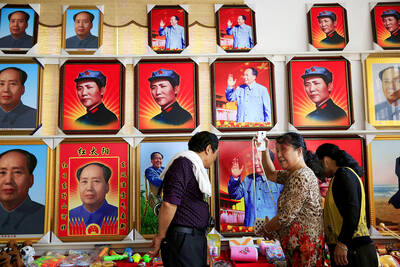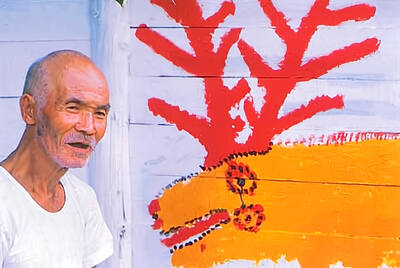A walking tour of a major metropolis might not seem to be the most convenient, enjoyable or safest way to sightsee while touring Taiwan. But life moves slowly in Tainan and exploring the historic city on foot is fun, especially for those with a whim for history or ancient and colorful Chinese architecture.
The nation's first official capital from between 1663 and 1885, Tainan is one of the few places in the country where history has been spared the wrecking ball and much of its long and colorful past can still be seen today. Walking is the most convenient way of seeing the 200 temples and countless Ming Dynasty (1368 to 1644) and Qing Dynasty (1644 to 1911) structures that help make up Taiwan's history.

PHOTO: GAVIN PHIPPS, TAIPEI TIMES
The ideal place to begin a tour of Tainan is in the Anping District (安平區), where Koxinga (鄭成功) landed in Taiwan nearly 400 years ago and drove out the Dutch. Little remains of the original Anping Fort (安平古堡), which was destroyed by a typhoon in the 1800s, but several of the original Ming Dynasty red-brick walls, now strewn with the gnarled roots of banyan trees, offer vestiges of years gone by.
For a less tourist-oriented glimpse of Tainan's early days visitors need only walk out of the fort's main gate and enter anyone of the numerous adjoining alleyways. Here, countless buildings dating back several hundred years sit as they have for generations. Many of the structures are in ruins, but even so they give visitors an insight into construction methods and materials used during the Ming and Qing periods.
Touring the city itself is hassle free, as brown road signs direct visitors to all of the popular tourist attractions. The most prominent of these include the Confucian Temple (孔子廟), which was established in 1665; Chihkan Tower (once dubbed the "Tower of Red-haired Barbarians") built by the Dutch in 1653; the 300-year-old Grand South Gate (大南門); the Five Concubines Temple (五妃廟) which was built in 1683; and the imposing Great Queen of Heaven Temple (大天后宮), which was built in 1665 and served as an imperial residence.
Visitors wanting to seek out tourist-free historical buildings and temples need not look far in Tainan, as numerous narrow alleyways snake their way through the city and it's here that much of the old-worldly charm of Tainan sits hidden away waiting to be discovered.
These alleyways, where time has stood still and life seems to move at a snail's pace, can be found adjacent to nearly all of the city's smaller temples. They might be only a stone's throw from a major thoroughfare, but they are all places where, save for the odd barking dog, visitors can easily forget they are in a metropolis.
One of the most interesting and charming of these areas is Beishih Street (北勢街), which is part of an going project to restore what remains of the city's old western district. The narrow cobble-stoned alley is lined with renovated two-story structures, some of which date back more than 150 years.
Sadly not all of the old buildings in the area have survived, as visitors will discover when they reach the bustling junction of Beishih Street and Haian Road. The shattered outer walls are all that remain of many of the buildings that once lined what is now a major thoroughfare. As if to add insult to injury, many have been transformed into garish works of modern art.
While the eye-catching architecture and temples provide the focal point of a cultural excursion to Tainan, visitors may also spend a couple of hours shopping and purchase some gaudy fashion wear and accessories along the bustling shopping area adjacent to Chungcheng and Haian roads.
If shopping for last decades' fashions becomes a chore you might want to hang out at some of Tainan's trendy outdoor tea/coffee shops. Half a dozen teashops regularly open for business along the sidewalks close to the junction of Haian and Mingsheng roads.
Visitors looking to learn more about Tainan should check out Heritage Books. Located opposite the Confucian Temple, the small bookstore stocks a wide range of hefty tomes relating to the history of the city and Taiwan. While much of the more in depth material is available in Chinese-language only, the store stocks English-language guides and the staff are willing to help with enquiries.
Fortune Teller Street is adjacent to the War God Temple on Yungfu Road and the narrow alleyway is lined with small cramped stores where fortune tellers hang out. They have the ability to predict the future by comparing facial moles, or by analyzing your date of birth and its relationship to the Chinese Zodiac.

Taiwan can often feel woefully behind on global trends, from fashion to food, and influences can sometimes feel like the last on the metaphorical bandwagon. In the West, suddenly every burger is being smashed and honey has become “hot” and we’re all drinking orange wine. But it took a good while for a smash burger in Taipei to come across my radar. For the uninitiated, a smash burger is, well, a normal burger patty but smashed flat. Originally, I didn’t understand. Surely the best part of a burger is the thick patty with all the juiciness of the beef, the

The ultimate goal of the Chinese Communist Party (CCP) is the total and overwhelming domination of everything within the sphere of what it considers China and deems as theirs. All decision-making by the CCP must be understood through that lens. Any decision made is to entrench — or ideally expand that power. They are fiercely hostile to anything that weakens or compromises their control of “China.” By design, they will stop at nothing to ensure that there is no distinction between the CCP and the Chinese nation, people, culture, civilization, religion, economy, property, military or government — they are all subsidiary

Nov.10 to Nov.16 As he moved a large stone that had fallen from a truck near his field, 65-year-old Lin Yuan (林淵) felt a sudden urge. He fetched his tools and began to carve. The recently retired farmer had been feeling restless after a lifetime of hard labor in Yuchi Township (魚池), Nantou County. His first piece, Stone Fairy Maiden (石仙姑), completed in 1977, was reportedly a representation of his late wife. This version of how Lin began his late-life art career is recorded in Nantou County historian Teng Hsiang-yang’s (鄧相揚) 2009 biography of him. His expressive work eventually caught the attention

This year’s Miss Universe in Thailand has been marred by ugly drama, with allegations of an insult to a beauty queen’s intellect, a walkout by pageant contestants and a tearful tantrum by the host. More than 120 women from across the world have gathered in Thailand, vying to be crowned Miss Universe in a contest considered one of the “big four” of global beauty pageants. But the runup has been dominated by the off-stage antics of the coiffed contestants and their Thai hosts, escalating into a feminist firestorm drawing the attention of Mexico’s president. On Tuesday, Mexican delegate Fatima Bosch staged a